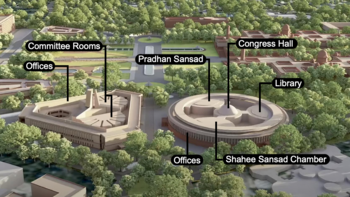Shahee Sansad
Shahee Sansasd शाही संसद | |
|---|---|
| 20th Shahee Sansad | |
 | |
| Type | |
| Type | |
| Houses | Council of States House of Representatives |
| History | |
| Founded | October 17, 1946 |
| Preceded by | Satria Etrurianan Colonial Administration |
New session started | September 15, 2020 |
| Leadership | |
Krishan VII since April 1984 | |
Adyaksh | XX1 since February 2012 |
Speaker | Devki Modhwadia1 since September 2015 |
Leader of the Opposition | |
| Structure | |
| Seats | 750 Consisting of 250 Councillors and 500 Members of Parliament |
 | |
Council of States political groups |
|
 | |
House of Representatives political groups | |
Joint committees | See Joint Committees of the Shahee Sansad |
Length of term | 5 years, renewable (House of Representatives) |
| Elections | |
Council of States voting system | Via appointment |
House of Representatives voting system | First-past-the-post and party-list proportional representation |
House of Representatives first election | October 1946 |
House of Representatives last election | September 2020 |
House of Representatives next election | September 2025 |
| Motto | |
| "Sadbhaav mein, Satyanishtha se" Transl.: In Concord, With Integrity | |
| Meeting place | |
 | |
| The Sansad Bhavan, Government Hill, Kinadica | |
| Constitution | |
| Constitution of the Kingdom of Rajyaghar Standing Orders of the Shahee Sansad | |
| Footnotes | |
| 1 = Required to be independent by Standing Orders | |
The Parliament of Rajyaghar, officially and commonly referred to as the Shahee Sansada, is the federal and supreme bicameral legislature of the Kingdom of Rajyaghar. The Shahee Sansad is comprised of 3 elements: the Crown, the Council of States and the House of Representatives. The Shahee Sansad, and wider rajyani political system, is modelled off of the Northabbey model in which the executive government finds its members from within the legislature. The Monarch has the exclusive power to summon, prorogue and dissolve the Shahee Sansad but by convention this is only done following the Monarch taking advice from the Premier.
The upper house, the Council of States, consists of 250 members: 112 are the leaders of the registered Clans, 100 are appointed at the discretion of the Monarch, 30 are appointed from amongst the military and 8 are religious appointees. It's members, called Councillors, are appointed in different ways and serve for varying periods of time, dependent upon the method of their appointment. All members of the Council of States are required to be non-partisan and must resign any party membership before their appointment.
The lower house, the House of Representatives, consists of 500 members called Members of Parliament. 400 of the members are elected using first-past-the-post voting from single-member electoral districts called constituencies. An additional 100 members are elected via the party-list proportional representation system with parties requiring 3% of the national vote in order to win seats. This system has lead to the House consisting of multiple political parties, ranging from the larger Rajyani Rashtriya and Cooperative parties to the smaller TNP and IC. The government of the day must achieve the confidence of this House in order to gain and remain in power.
The House of Representatives has a maximum term of five years, although it can be dissolved early. The Council of States has fixed terms with the length of the term, and status as being renewable or not, dependent method of appointment they were appointed by. When the Shahee Sansad is dissolved, it is only the members of the House which lose their positions and must seek re-election. Councillors retain their positions with their terms suspended until the Shahee Sansad is reopened. Due to the composition of the Shahee Sansad, Rajyaghar is often considered a southern democracy or flawed democracy.
The two Houses meet in separate chambers of the Sansad Bhavan on Government Hill in Kinadica.
History
Parliamentary Complex
Sansad Bhavan
Sangh Bhavan
Composition
House of Representatives
Sansad ke Sadasy is the official name given to members of the Shahee Sansad, abbreviated as SS and used as a suffix. Commonly, Sansad ke Sadasy are referred to via the estmerish translation of the name; Member of Parliament (abbrv. MP).
The House of Representatives is made up of 500 members which belong to one of two 'classes', all being called Members of Parliament.
- Class 1 - Directly elected, single member constituency representatives (400)
- Class 2 - Representatives elected via the Closed party-list proportional representation system (100)
Class 1 members are directly elected by the electorate via a first-past-the-post voting system in electoral districts named constituencies. These constituencies are represented by only one class 1 Member of Parliament and the borders of the constituencies are drawn up by the Independent Boundary Commission (IBC), a non-partisan public body. Class 2 members are also directly elected but via the closed party-list proportional system in which citizens elligble to vote cast a vote for a political party rather than an individual. As a result, at each federal general election, voters cast 2 votes; one for their consitituency representative and one for their preferred political party. Only parties which secure 3% of the national vote are allocated Class 2 seats. All members of the House are elected every 5 years, or earlier, at the general election and are not term limited.
Speaker of the House
The Constitution of Rajyaghar dictates that the House must have a Speaker and at least two Deputy Speakers to preside over sessions of the Parliament. As per the Constitution, the Speaker and Deputy Speakers, must be elected by a simple majority of members present and voting in the House. Other than being Members of Parliament, the Constitution does not set out any specific qualifications for being elected Speaker. However, the Standing Orders of the House dictate that the Speaker must resign their political party membership when they become Speaker in order to be independent and non-partisan. Due to the impartiality of the Speaker, there is an unwritten convention that political parties will not contest the election of the Speaker's constituency so as to allow them to run unopposed, if they are a Class 1 MP. Due to this convention, all Speakers have been Class 1 members.
The Speaker is both a member and presiding officer of the House of Representaatives and conducts regular business in the House. However, the Speaker does not vote except on those rare occasions when there is a tie at the end of a decision. In the event of resignation, death or removal, the senior Deputy Speaker shall become Acting Speaker of the Shahee Sansad and a new election for Speaker will take place. Speakers and Deputy Speakers can be removed by the House through a vote of no confidence with 2/3rds of the House being required to vote in favour of removal. If no Deputy Speakers are available, the Monarch will appoint an acting-Speaker.
In the 20th Shahee Sansad, Devki Modhwadia is the current Speaker. Mr. Modhwadia has served as Speaker since the opening of the 19th Shahee Sansad in September 2015.
House Leadership
The parliamentary leadership of the House of Representatives can be split into functional leadership and party political leadership. The functional leadership consists of the Speaker and Deputy Speakers with the party political leadership consisting of the parliamentary leaders of the political parties. Each political party typically has the following parliamentary leadership:
| Party Political Leadership Position | Position if in Government | Position if in the official opposition |
|---|---|---|
| Party Leader | Prime Minister | Leader of the Opposition |
| Deputy Party Leader | Senior Secretary of State | Senior Shadow Secretary of State |
| Caucus Leader1 | Leader of the House | Shadow Leader of the House |
| Chief Whip | Government Chief Whip | Opposition Chief Whip |
The order of precedence within the House of Representatives is as follows:
- Speaker of the House
- Deputy Speakers (x2)
- Premier of Rajyaghar
- Cabinet Ministers
- Opposition Party Leaders (by parliamentary party size)
- Members of Parliament (by length of service)
Council of States
Members of the Council of States are given the name of Councillors and, like the House of Representatives, are split into classes:
- Class 1 - Leaders of the registered Clans (112)
- Class 2 - Royal appointees (100)
- Class 3 - Military appointees (30)
- Class 4 - Religious appointees (8)
Class 1 members are the leaders of registered clans with the Ministry of Clan and Local Affairs (MCLA). At present, there are 112 registered clans. If more clans are recognised by the MCLA, then the number of Class 1 members increases at the expense of Class 2 membership as when class 2 members conclude their term they will not be invited to return. Class 1 members serve for as long as they are leaders of their clans. Leadership of clans is an internal clan affair but their leadership process must be uniform and recorded by the MCLA.
Class 2 members are appointed by the Monarch on the advice of the Independent Royal Appointments Commission (IRAC), a non-partisan public body which also provides the Monarch wtih advice regarding the appointment of ambassadors, chief civil servants and other positions. Class 2 members are first appointed for a term of 12 years and can then be reappointed for additional, renewable 6 year terms. Class 2 members cannot be reappointed after turning 75.
Class 3 members are members of the armed forces and are appointed by the Monarch on the advice of the Joint Chiefs of Staff. 10 members come from the navy, 10 from the army and 10 from the airforce. The Chairman of the Joint Chiefs, Chiefs of the Army, Navy and Airforce all automatically take up one of these seats each with the remainder being assigned by the Joint Chiefs. Military appointees serve at the discretion of the Joint Chiefs.
Class 4 members are religious appointees appointed by the Monarch on the advice of varying bodies. 1 of the appointees is always the High Priest of Bishnupur who then advises the monarch on the appointment of four other tulyatan religious leaders. The three remaining appointees are appointed on the advice of the Rajyani Badist Council, Council of Archbishops and the Irfanic Council or Rajyaghar.
Adyaksh
The Constitution of Rajyaghar dictates that the presiding officer of the Council of States is the Crown Prince of Rajyaghar. In reality, the day to day duties of the Crown Prince are conducted by the Adyaksh (transl. Chairman) who is elected by a simple majority of members present and voting in the Council of States. The Constitution, whilst establishing the role of the Adyaksh, does not set any requirements or qualifications for the role other than those prescribed to Councillors as a whole. In accordance with the Standing Orders of the Council, the Adyaksh must come from amongst the Class 2 Councillors thus preventing any clan, military or religious preference. In the event of resignation, death or removal, the Crown Prince shall resume full presidium functions until the election of a new Adyaksh. The Council can remove an Adyaksh through a vote of no confidence with 2/3rds of the Council being required to vote in favour of removal.
In the 20th Shahee Sansad, XX is the current Adyaksh. XX has served as Adyaksh since his election in the 18th Shahee Sansad in February 2012.
Powers and Duties
Legislative Function
Executive Function
Judicial Function
Sessions of Parliament
State Opening of the Shahee Sansad
Legislative Procedure
Privileges
References
1 = Caucus leader is often merged with Party Leader for political parties which are neither the Governing or Official Opposition parties.

